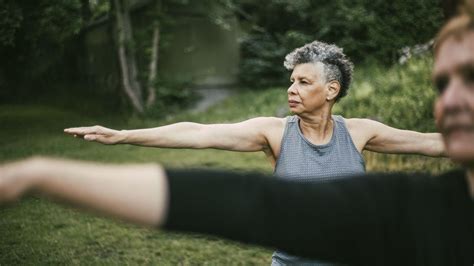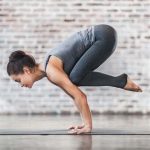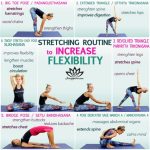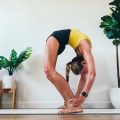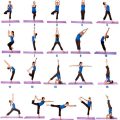Flexibility Boost with Yoga: 5 Essential Poses for Maximum Results
Yoga has been widely praised for its ability to improve flexibility, but not all poses are created equal. This guide explores five key moves that provide the most substantial flexibility improvements, tailored for beginners and seasoned practitioners alike. Flexibility is not just about physical health but impacts posture, injury prevention, and mental relaxation. By understanding how these poses work and why they are effective, you can maximize your yoga practice to see noticeable improvements in flexibility and overall wellbeing.
Introduction
Flexibility is a crucial aspect of physical health, affecting everything from muscle recovery to daily activities like bending, reaching, or sitting comfortably for extended periods. Yoga, an ancient practice that combines physical postures, breathing exercises, and meditation, has become one of the most popular ways to enhance flexibility. The combination of static and dynamic stretching in yoga not only loosens tight muscles but also lengthens them over time, promoting joint mobility and overall body balance.
In this article, we’ll explore five yoga poses specifically designed to increase flexibility. Each pose targets different muscle groups, and when practiced consistently, they help in improving overall body suppleness. Whether you’re a beginner or an experienced yogi, these five poses will help unlock greater mobility and flexibility.
Key Concepts
- Flexibility: The ability of muscles and joints to move through their full range of motion.
- Static Stretching: Holding a position to stretch a muscle without movement.
- Dynamic Stretching: Stretching through movement, often used to warm up muscles before exercise.
- Range of Motion (ROM): The full movement potential of a joint, usually measured in degrees of a circle.
- Mind-Body Connection: The awareness of how the body moves and the mental engagement needed to achieve correct posture.
Historical Context
Yoga’s emphasis on flexibility dates back over 5,000 years to its origins in ancient India. Initially practiced as a spiritual discipline, yoga was designed to prepare the body for long periods of meditation. Over time, yoga evolved into a physical practice that not only enhances mental clarity but also promotes physical well-being, especially in terms of flexibility.
Many modern yoga practitioners are drawn to the flexibility benefits, incorporating poses that elongate muscles and increase mobility. These yoga poses have been fine-tuned through centuries, making them highly effective for improving flexibility in specific areas of the body.
Current State Analysis
In today’s fitness world, flexibility is often an overlooked component. With the rise of sedentary lifestyles and jobs that require long periods of sitting, many people experience tight muscles, poor posture, and restricted range of motion. Yoga poses, when performed correctly, can counteract these issues by stretching major muscle groups like hamstrings, hips, back, and shoulders.
Many studies have shown the effectiveness of yoga in enhancing flexibility, especially for beginners who often see rapid improvement. However, a common misconception is that only flexible people can do yoga. The truth is that yoga adapts to your current flexibility level, making it accessible for everyone.
Practical Applications
Yoga poses for flexibility can be incorporated into various daily routines. These five key moves, described below, should be practiced at least three times a week for noticeable improvements:
1. Downward Facing Dog (Adho Mukha Svanasana)
Targeted Muscles: Hamstrings, calves, shoulders, and upper back.
How It Works: By bending forward and extending your arms and legs, you create a stretch through the posterior chain of the body. This lengthens and strengthens these muscles over time, enhancing flexibility in the back and legs.
Tips: Keep your knees slightly bent if you’re a beginner, focusing on elongating your spine rather than touching your heels to the ground right away.
2. Forward Fold (Uttanasana)
Targeted Muscles: Hamstrings, lower back, calves.
How It Works: A simple but effective stretch, Forward Fold stretches the entire back side of the body. Regular practice improves flexibility in the spine and hamstrings.
Tips: Don’t force yourself to touch your toes—bend your knees if needed and focus on keeping your back straight.
3. Pigeon Pose (Eka Pada Rajakapotasana)
Targeted Muscles: Hips, glutes, lower back.
How It Works: Pigeon Pose opens up the hips, an area where many people hold tension. It’s highly effective in improving hip flexibility, which is often restricted from prolonged sitting.
Tips: Ensure your hips are square and don’t collapse forward; use a blanket under the hip if you feel discomfort.
4. Cobra Pose (Bhujangasana)
Targeted Muscles: Lower back, spine, chest, and shoulders.
How It Works: This gentle backbend stretches the chest and shoulders while strengthening the lower back. It’s beneficial for increasing spinal flexibility.
Tips: Engage your core and press through your pelvis to avoid straining the lower back.
5. Bound Angle Pose (Baddha Konasana)
Targeted Muscles: Inner thighs, groin, hips.
How It Works: This pose opens up the inner thighs and groin, promoting flexibility in the hips and improving range of motion in the legs.
Tips: Sit on a cushion if your knees are high off the ground to make the pose more comfortable.
Case Studies
| Case Study | Challenges | Results |
|---|---|---|
| John, 45, Office Worker | Poor posture and tight hamstrings from sitting all day | After practicing yoga 3x per week for 2 months, John experienced improved posture and could touch his toes for the first time in years |
| Sarah, 30, Runner | Tight hips and lower back pain | Incorporating Pigeon Pose and Forward Fold helped reduce Sarah’s lower back pain and increased her hip flexibility, leading to better running performance |
Stakeholder Analysis
- Beginner Yoga Practitioners: Will benefit from gentle poses and modifications that improve flexibility over time.
- Advanced Yoga Practitioners: Can deepen these poses to continue enhancing flexibility.
- Athletes: Yoga can complement their training by increasing flexibility and reducing the risk of injury.
- Physical Therapists: May incorporate yoga poses to aid in recovery and promote muscle flexibility.
Implementation Guidelines
For maximum flexibility gains, these five poses should be practiced at least 3-4 times a week. Start with short sessions (10-15 minutes) and gradually increase the time spent in each pose. Beginners should focus on breathing and posture rather than pushing for depth, as this ensures safe and effective stretching. More experienced practitioners can hold poses longer and incorporate flowing sequences to deepen the stretch.
Ethical Considerations
While yoga is widely beneficial, it’s important to consider the cultural origins of the practice. Many Western adaptations focus solely on the physical aspects, disregarding the spiritual roots of yoga. Acknowledging and respecting the cultural significance of yoga is key to an ethical practice.
Limitations and Future Research
Though yoga can significantly improve flexibility, it may not be a standalone solution for everyone. Factors such as age, injury, and genetic predispositions can influence how quickly or effectively an individual sees improvements. Additionally, more research is needed to explore yoga’s long-term impact on flexibility and joint health across different age groups and fitness levels.
Expert Commentary
Experts agree that yoga is one of the most effective methods for improving flexibility, especially when practiced consistently over time. According to Dr. Sarah Lee, a physical therapist, “The combination of stretching, strengthening, and mindfulness in yoga provides a holistic approach to flexibility training, making it accessible to people of all ages and fitness levels.”
However, experts also caution against overdoing certain poses, as forcing flexibility can lead to injury. It’s always advisable to listen to your body and consult a trained yoga instructor if you’re unsure about your technique.
